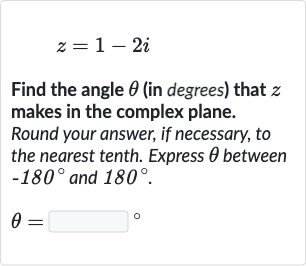Full solution
Q. Find the angle (in degrees) that makes in the complex plane.Round your answer, if necessary, to the nearest tenth. Express between and .
- Calculate Argument using Arctangent: To find the angle that the complex number makes in the complex plane, we need to calculate the argument of the complex number. The argument is the angle formed by the real axis and the line segment representing the complex number in the complex plane. We can use the arctangent function to find this angle, which is given by the formula .
- Identify Real and Imaginary Parts: First, identify the real part and the imaginary part of the complex number . Here, the real part is , and the imaginary part is .
- Use atan Function: Now, use the atan function to find the angle in radians. The atan function takes into account the signs of both the real and imaginary parts to determine the correct quadrant for the angle. The formula is , so we have .
- Calculate Angle in Radians: Calculate the angle using a calculator or a programming language that has the atan function. The angle in radians is .
- Convert Radians to Degrees: Convert the angle from radians to degrees, since the question asks for the angle in degrees. To convert radians to degrees, multiply the angle in radians by . If we assume the angle in radians from the previous step is correct, the conversion to degrees would be .
- Adjust Angle if Necessary: After calculating the angle in degrees, make sure that it falls within the specified range of degrees to degrees. If the calculated angle is outside this range, adjust it by adding or subtracting degrees until it falls within the range.
- Perform Calculation for Degrees: Perform the calculation to find the angle in degrees. Assuming the angle in radians is correct, we would have . Using a calculator, we find that degrees.
- Check Angle Range: Check if the calculated angle is within the range of degrees to degrees. Since degrees is within this range, no further adjustments are needed.

